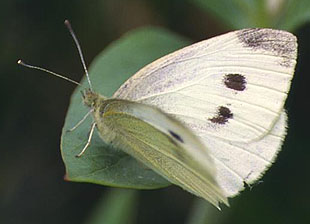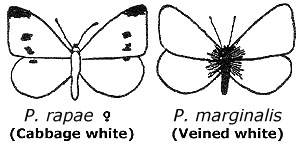
BUG OF THE MONTH: April 1993
Pieris rapae, the Cabbage White Butterfly
Copyright © 1993 by Louise Kulzer
This article originally appeared in Scarabogram, April 1993, New Series No. 156, pp. 2-3.
|
|
| Pieris rapae female © Markku Savela |
Spring no sooner peeks around an April cloud than the cabbage butterflies are on the wing, searching out broccoli and cabbage starts, nectaring on dandelions and Luminaria flowers. Actually, cabbage butterflies are not much of a pest at all compared with cabbage root maggots. So I prefer to think of them as an ideal study population for home-bound entomologists. There are lots of them, they fly right in your yard, they have a really long season, and they have qualities as interesting as more exotic insects. They are not native, but from Europe, and compete with our native white, Pieris marginalis (formerly napi), to its detriment. All the more reason to take specimens for study!
The sex of cabbage butterflies can be readily determined. In addition to the dark spot at the outer "corner" of the forewing, upper (dorsal) side, females have two dark spots mid-wing, one above the other; males have only one. So right away you can study the proportion of females versus males over the season. There is also a tendency for early individuals to have much lighter markings than later ones, which adds interest and makes it harder to separate light cabbage butterflies from our native veined white, P. marginalis, which flies in suburban areas with good tree cover.

In veined whites, the wing tip is unmarked, and the veins are sometimes lined in black (hence the common name). The dark vein scales may be lacking, says Pyle, in the summer, and, says Christensen, in "later broods," but in my experience unmarked individuals are seen early in the season. Veined whites can also show dark sex spots (2 in females, 1 in males) but the male spot is often absent.
Cabbage white butterflies overwinter as pupae and emerge in early spring. After mating they lay their eggs on plants of the mustard family (crucifers), but particularly relish cabbage and broccoli plants. Eggs are usually laid on the underside of the leaf, where the caterpillars also hang out. Caterpillars are a velvety green with faint white lines along the sides. They chew big holes in the leaves. If you see this kind of damage, turn the leaf over and look carefully: you can probably apprehend the culprit.
Cabbage white butterflies are easy to rear, and are great to bring into the classroom, where they will continue feeding, pupate, and emerge in about three weeks.
An interesting, easily observed behavior is the spiral flight. When a male shows interest in a female that has already mated, she indicates her lack of interest by rising, the two butterflies circling each other, until the male loses interest and drops back to the ground. The female then comes down more slowly and resumes egg-laying (Stokes 1983).
I've always wanted to do a capture-recapture study on cabbage white butterflies for a day or two and see if a population estimate in my Ballard neighborhood could be made. (You can mark butterflies by applying nail polish to the wings). This is only one of many interesting studies possible in your own back yard.
References
Christensen, James R. 1981. A field guide to the butterflies of the Pacific Northwest. Northwest Naturalist Books, University Press of Idaho.
Pyle, Robert M. 1981. The Audubon Society Field Guide to North American Butterflies. Alfred A. Knopf, New York.
Stokes, Donald. 1983. A guide to observing insect lives. Little, Brown & Co.
This page last updated 16 June, 2005